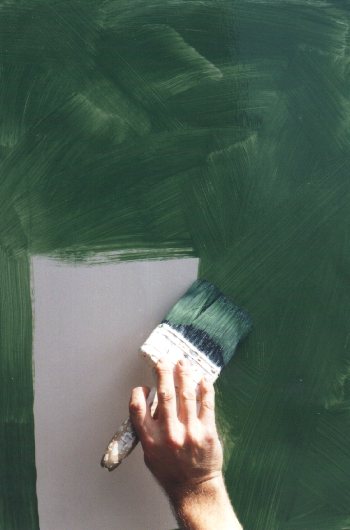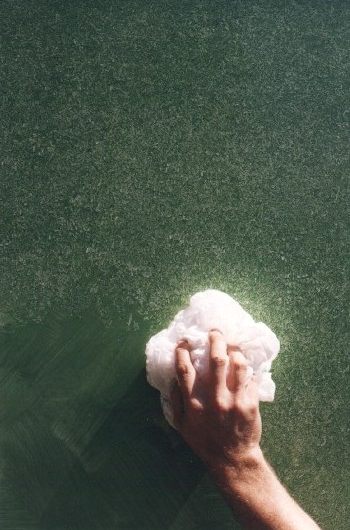- Dust sheets or similar material to protect carpets furniture etc.
- Disposable plastic gloves (optional).
- A bucket or bowl of clean water plus rags for cleaning.
- A tin of paint thinned with transparent glaze according to manufacturers instructions.
- A roller and tray and/or a brush.
- Several polythene bags.
Like all paint-effects, bagging can be a little messy, so wear old clothing or overalls.
Also: remove or cover all carpets, furniture and other valuables from the room.
Prepare
the surface that is to be painted, apply at least 2 coats of mid-sheen paint in your chosen
colour
and allow to dry thoroughly.
Water-based paint dries quickly so start on your smallest walls first; your speed will improve with experience.
Have a bucket or bowl of clean water and some rags close at hand for cleaning purposes.
BAGGING PROCESS.
In this technique the topcoat, or glaze, is patterned by dabbing a crumpled bag over the surface.
Where the bag makes contact, the glaze is lifted revealing the base coat.
It is advisable to get someone else to paint the wall with the mixed glaze ahead of you, so that you can concentrate on creating the effect
If you must work alone, paint small sections, 3ft (1 metre) at a time, & stop the bagging process 6 inches (150mm) short of the leading edge.
Apply the mixed glaze evenly with a brush or roller.
Take a polythene bag; turn it inside out to remove any contents and to avoid the possibility of print being transferred to the wall surface.
Crumple the bag up, and then allow it to open out a little, making sure there are lots of creases and folds.
Dab the crumpled bag onto the surface of the glaze and lift it back off.
Twist your hand about 450, then dab again next to, & overlapping, the first dab.
The challenge of bagging is to move the bag evenly over the surface without twisting or sliding it in the glaze.
Occasionally open out, and re-bunch the bag, or replace it, to keep a regular appearance to the pattern.
Repeat the process over the area to be decorated, lapping-in on wet edges.
Allow the first wall to dry before starting another to prevent spoiling the finished effect.
Allow the paint to dry before protecting with a coat of clear glaze or varnish (optional).

Apply glaze.

Dab with bag.
!!! With oil-based
method, used bags should be saturated with soapy water before discarding to prevent the risk of fire !!!
The more contrast between the basecoat and topcoat; the more pronounced the pattern will be. (Especially important with this effect)
You should not add white to the basecoat colour to make the topcoat, or vice versa. This gives poor results unless the contrast is strong.
An oil-based basecoat will greatly improve the working time of the glaze. It is advisable to use an oil-based topcoat too in this instance.
You needn't worry about getting paint on the ceiling or woodwork, this can be corrected later & avoiding these areas will spoil the effect.
Colours should be related in some way, either different tones of the same colour, or similar tones of related colours.
Dark or strong colours give a rich effect, but the base-coat must be fairly light compared to the glaze for the effect to be visible.
Variations in finish can be achieved using different types of material such as paper rather than cellophane.
![]()
![]()